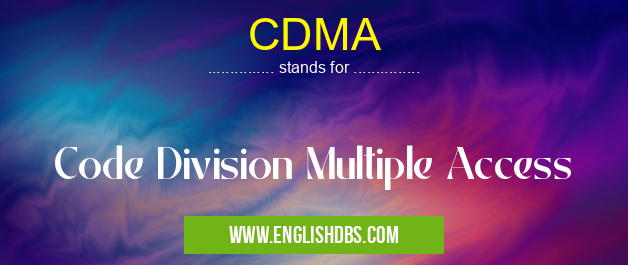What does CDMA mean in MOBILE
CDMA stands for Code Division Multiple Access, a cellular network technology that allows multiple users to share the same frequency channel without causing interference. It divides the available bandwidth into multiple codes, each assigned to a specific user. This enables a more efficient use of the spectrum and increased capacity compared to other access methods like FDMA (Frequency Division Multiple Access) or TDMA (Time Division Multiple Access).

CDMA meaning in Mobile in Computing
CDMA mostly used in an acronym Mobile in Category Computing that means Code Division Multiple Access
Shorthand: CDMA,
Full Form: Code Division Multiple Access
For more information of "Code Division Multiple Access", see the section below.
Key Features of CDMA
- Spread Spectrum Technology: CDMA uses spread spectrum technology, which distributes the signal's energy over a wider frequency range. This makes it more resistant to interference and jamming.
- Unique Codes: Each user is assigned a unique spreading code that modulates their signal. These codes are orthogonal, meaning they are designed to minimize interference with each other.
- Increased Capacity: By allowing multiple users to share the same frequency, CDMA significantly increases the capacity of a cellular network.
- Soft Handoff: CDMA supports soft handoff, allowing a device to seamlessly switch between cell towers without dropping the connection.
- Improved Security: The spread spectrum technology and unique codes make CDMA more secure than other access methods.
Applications of CDMA
CDMA is primarily used in cellular networks, including:
- 2G: IS-95 (Interim Standard 95) for second-generation cellular networks.
- 3G: CDMA2000 for third-generation cellular networks.
- 4G: WCDMA (Wideband CDMA) for fourth-generation cellular networks.
Advantages of CDMA
- Increased capacity and efficiency
- Improved interference resistance
- Soft handoff capabilities
- Enhanced security
Disadvantages of CDMA
- Higher power consumption compared to some other access methods
- Potential for multipath interference in certain environments
Essential Questions and Answers on Code Division Multiple Access in "COMPUTING»MOBILE"
What is CDMA?
Code Division Multiple Access (CDMA) is a digital cellular phone technology that uses spread spectrum techniques to encode and transmit information. By spreading the signal across a wider frequency range, CDMA allows multiple users to simultaneously share the same frequency band without interference.
How does CDMA differ from other wireless technologies like GSM?
CDMA uses spread spectrum technology, while GSM (Global System for Mobile Communications) uses time division multiple access (TDMA). In CDMA, each user's signal is assigned a unique code, allowing them to use the same frequency simultaneously. In TDMA, users are assigned specific time slots, preventing overlap.
What are the advantages of CDMA?
CDMA provides increased capacity, improved call quality, and greater security compared to analog systems. Additionally, CDMA supports data and voice transmission, enabling a wider range of services.
What are the limitations of CDMA?
CDMA requires more complex and expensive hardware than analog systems, making it initially more costly to implement. Additionally, CDMA can suffer from interference in certain environments, such as areas with high levels of electromagnetic noise.
Is CDMA still used today?
While CDMA was once a dominant cellular technology, it has largely been replaced by more advanced technologies such as GSM and LTE (Long-Term Evolution). However, CDMA is still used in some regions, particularly in rural areas where network coverage is limited.
Final Words: CDMA is a widely used cellular network technology that provides increased capacity, improved interference resistance, and enhanced security. Its unique code-based design allows multiple users to share the same frequency channel efficiently, making it a valuable solution for mobile communications.
CDMA also stands for: |
|
| All stands for CDMA |
